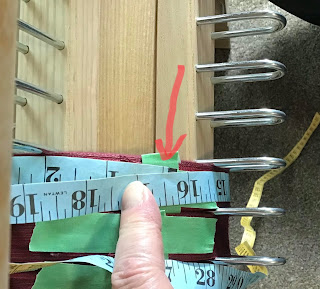circumference of the empty beam: 14.25" The arrow shows where 'zero' is on the tape measure, and therefore the circumference of the beam
circumference of beam with 60 layers of warp: 16.5
Since I am in the process of developing a new class for School of Sweet Georgia I have been paying a great deal more attention to the process as I have been doing it today with my next warp.
It occurred to me that a lot of people forget that the circumference of the beam will change as the layers build up, so if they just count the number of turns (which is how I've always done it), the actual length of the warp will be more than they think if they don't factor in this build up.
(Some people use other methods but my needs are different from most so I'll just talk about what I do in case it makes sense to anyone else.)
So how long IS my warp, anyway? About 22 tea towels, give or take. Because the actual length of any tea towel design will depend on how many picks I need to weave the motif and any hem/border that I want to include. This may vary from around 1000 picks to 1200 picks (or more), give or take. And depending on the yarn being used.
For example, the warp that is now in the washing machine had a towel repeat of 1256 picks. But that was 2/16 cotton with a target of 32 ppi. This warp? Is 2/20 cotton with a target ppi of around 40. This may change as the weft changes, so in the end I decided to use a short repeat, use a measuring tape to weave about 42" or so, then weave in a cut line (a contrasting colour) and when I've woven 8 towels, that section will get cut off and the tea towels separated for wet finishing. I will tie on and keep going until the next 8 towels are done, rinse, repeat until the warp is finished.
But I can get a rough estimate of the length by using the 'mean' circumference length. It's not entirely accurate, but can come pretty close. Subtract the actual circumference from the circumference of the warp which is a difference of 2.25". Half of 2.25 is 1.12" or for ease, say 1 1/8".
The half-way length would then be about 15.37" - or for ease 15 3/8", However, it is actually easier to do the next step using the 15.37" number so I'll use that. Half of the warp will be more than that mean, half will be less.
15.37 x 60 (turns) = 922.2 inches or about 25.6 yards.
These numbers really need to be worked out each time because the circumference will change depending on how many threads are in a section, how thick those threads are, how much tension they have been wound with and how many layers there are.
Since I have been a production weaver all my life, I have almost never tried to do a specific warp length (like 10.3 yards). My goal was to weave much longer warps in order to reduce the amount of time I spent dressing the loom, that is, threading and sleying. The longer the warp, the more items I can weave, and the less loom waste. A warp of 100 yards will have exactly the same amount of loom waste calculated as a 10 yard one. Therefore if there is 27" loom waste for a 10 yard warp, and also 27" loom waste for a much longer warp, say 40 yards, there is only 27" loom waste instead of 27 x 4 = 108" for that 40 yard warp.
Not everyone wants to do a 40 yard long warp however, so it becomes more important to them to work out how to measure their warp going onto the beam. Even when I do a 10 yard long warp however, I still want 'extra' in order to weave a header, spot any errors and fix them, check for ppi, check that I have no tie up errors, check for weft - both actual fibre/yarn and colour. So for me, winding on 20 turns for a 10 yard long warp (if the loom has a half yard circumference beam), works perfectly fine. The build up on a 10 yard long warp on a half yard beam isn't all that great, but it is a little and I use that 'extra' to test for the afore mentioned variable.
When I got rid of the AVL with its 1 yard circumference beam and got the Megado, I had to re-think my approach for the smaller circumference. So I spent quite a few warps doing warps of various numbers of turns, working out how many units of whatever it was I was weaving, then increasing or decreasing as my needs changed. It's not 'perfect' but that isn't all that important to me right now. That may change in the future. Or not.
I've written about sectional beaming elsewhere on this blog - put sectional beaming into the search bar and they should all come up. A blog isn't a format for a really deep dive into any topic, so I've addressed various bits and pieces of it over the years.
But sectional beaming does have some advantages - and some disadvantages. Once you know both, you can decide if the technique is appropriate for you.





No comments:
Post a Comment